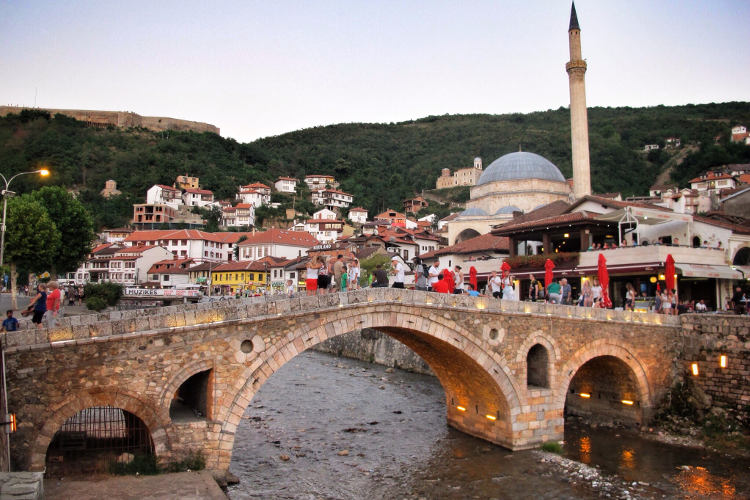
Throughout history Prizren has played an important role in the region which was first settled in Illyrian times. Situated at a major crossroad on the Balkan peninsula, the town hosted a handful of empires, with Byzantine and Ottoman architecture leaving the most distinctive marks on the cityscape. Ottoman vibes can be felt especially around Shadervan – near this main, cobbled square you’ll find a great selection of bars and restaurants, as well as the lovely Sinan Pasha Mosque (one of over 20 mosques in the city) and the Old Stone Bridge, which dates back to the 16th century but was reconstructed in the 1980s after it was destroyed by a flood. On the other side of the Bistrica (Lumbardhi) river, on Rr Adem Jashari, is the Gazi Mehmet Pasha Hammam; when it’s not being used as an exhibition space, it remains closed to the public.
Not far from the hammam, on Rr Sharri, is the Prizren League House, of particular importance for Albanian history as the site of the most significant attempt to unite all Albanians in the region within one state. The 14th-century Unesco-listed Church of the Virgin of Ljeviš is also of great historical significance – unfortunately, along with many other Serbian Orthodox churches in town, it’s closed to the public for now and requires approval to visit. The St George Church near Shadervan is an exception, and it’s here you can try to arrange to see the rest. Standing proudly on the hill above town is the 11th-century Prizren Fortress. Entrance is free and it’s open 24 hours a day, though climbing up for sunrise or sunset is highly recommended.
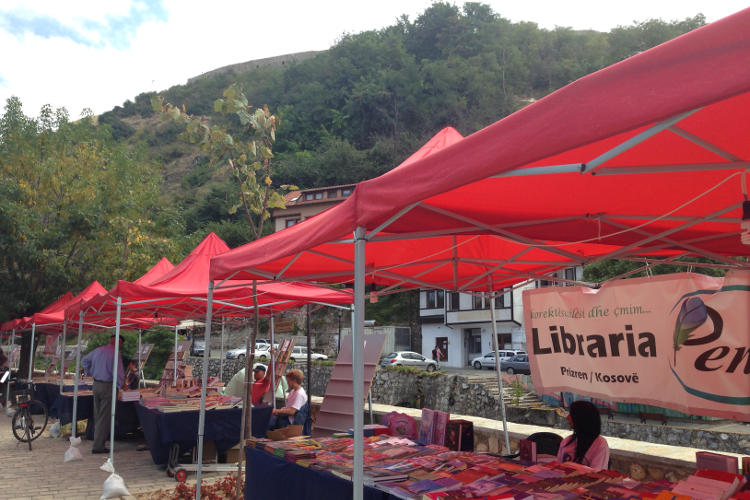
To witness Kosovo’s cultural capital at its liveliest and to enjoy a unique cinematic experience, there’s no better time to visit Prizren than during Dokufest (dokufest.com/2015). Ranked as one of the top international documentary and short film festivals in the world, this week-long event taking place every August transforms the entire historic centre of town into a living venue for photo exhibits, workshops, parties, and more than 200 film screenings, and brings in many international visitors. A few of the more memorable spots where you can catch a flick alfresco are in the fortress, above the Bistrica river and just behind the Sinan Pasha Mosque. Peja beer in hand is optional, of course.
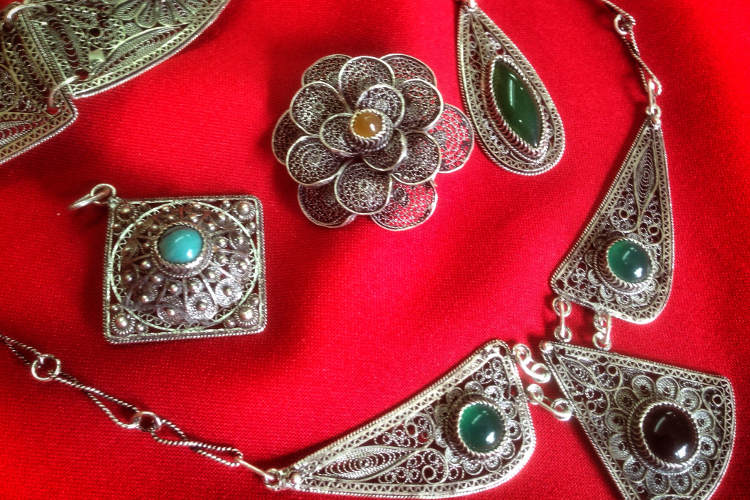
The ultimate shopping experience in Prizren is paying a visit to one of the city’s many filigree shops. This traditional technique in jewellery-making first arrived in Kosovo via Ottoman caravans around the 15th century and has remained an artisanal pride and joy of Prizren ever since. Filigrani (filigranpz.wix.com/filigran) is perhaps the best-known collective of filigree artists who occupy an all-but-abandoned building in northwest Prizren and famously welcome for a visit anyone who’s interested in seeing the metalsmithing magic happen. If time permits, you might even be able to give it a go yourself or, for the more serious, filigree courses lasting from a few weeks to a few months can be arranged. Keep in mind that for every 10 shops you see, perhaps only one sells products that were handmade locally – to ensure you’re buying the best-quality pieces and leaving your money where you should, ask for proof of authenticity.
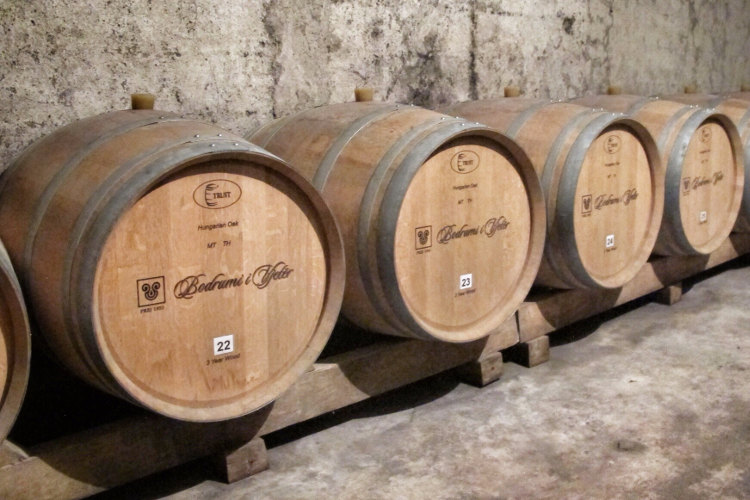
From its famed ëmbëltoret (confectioneries) to the best qebaptore (barbeque restaurants) you’ll find in the country, Prizren is the gastronomic heart of Kosovo. A savoury local speciality to try, aside from any kind of grilled meat, is djathë i Sharrit (Shar cheese), while those more interested in dessert can’t go wrong with tullumba (filo pastry soaked in syrup) or baklava (similar but including nuts) – no doubt the sweetest remnants of Prizren’s Ottoman past.
Nearby Rahovec (Orahovac) is the epicentre of wine production, which has been going on here for some 2000 years, so it’s no surprise that this is where you’ll find the largest of Kosovo’s wineries and a designated ‘wine route’. Bodrumi i Vjetër (haxhijaha.com/Bodrumi_i_Vjeter) and Stone Castle (stonecastlewine.com) are both available for a visit if organised in advance. Every September a wine festival takes place in Rahovec; dates vary each year so make sure you check with a local source before you arrive.
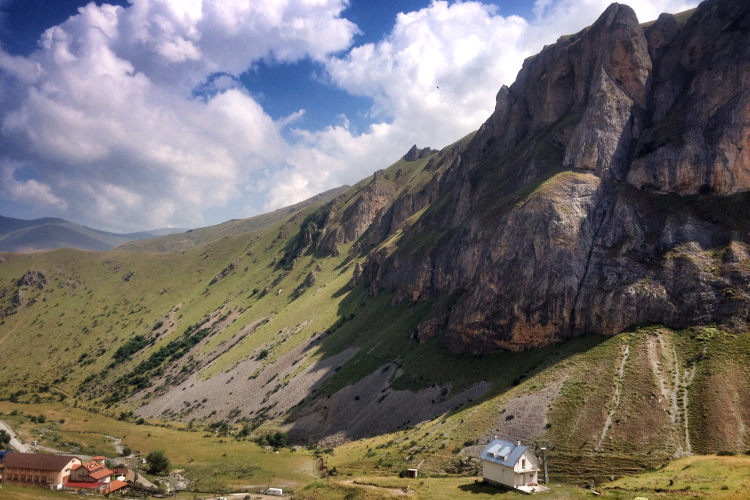
Prizren is a perfect starting point for exploring the Shar mountain range, which borders Macedonia and Albania, on either a day trip or overnight. Though barely updated since its heyday in the 1980s, when it was a downhill-ski backup for the 1984 Winter Olympics in Sarajevo, Brezovica (about 40km east of Prizren) is Kosovo’s main ski centre. In the non-winter months the area is beautiful for hiking, biking or picnicking; once the snow arrives, you can hit the slopes at the mercy of its seriously retro (but perfectly safe) ski lifts. Big changes are expected in the coming years, as a deal was recently signed with a French consortium slating Brezovica for a €400 million makeover.
The Dragash area (35km southwest of Prizren) is especially scenic with more than 150 species of medicinal plants growing in the wild, frequent encounters with roaming shepherds, and peaks over 2500m. Less than 3km south from the quaint village of Brod is Arxhena Hotel – a bit of a hidden treasure, with spectacular surroundings and development of its own ski offerings in the works.